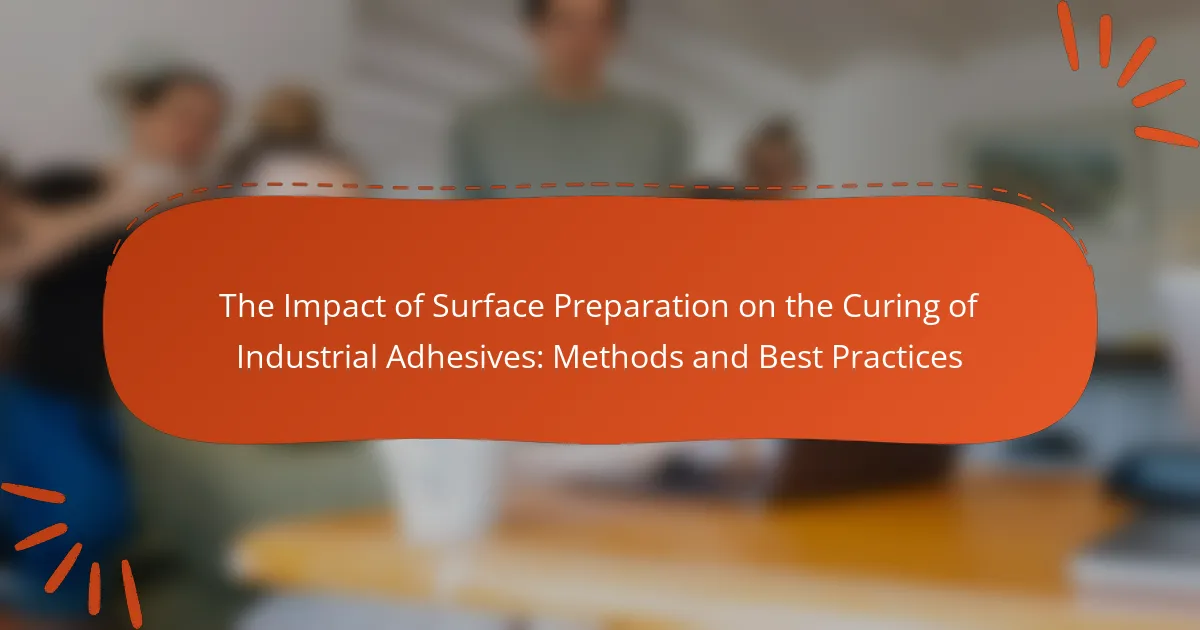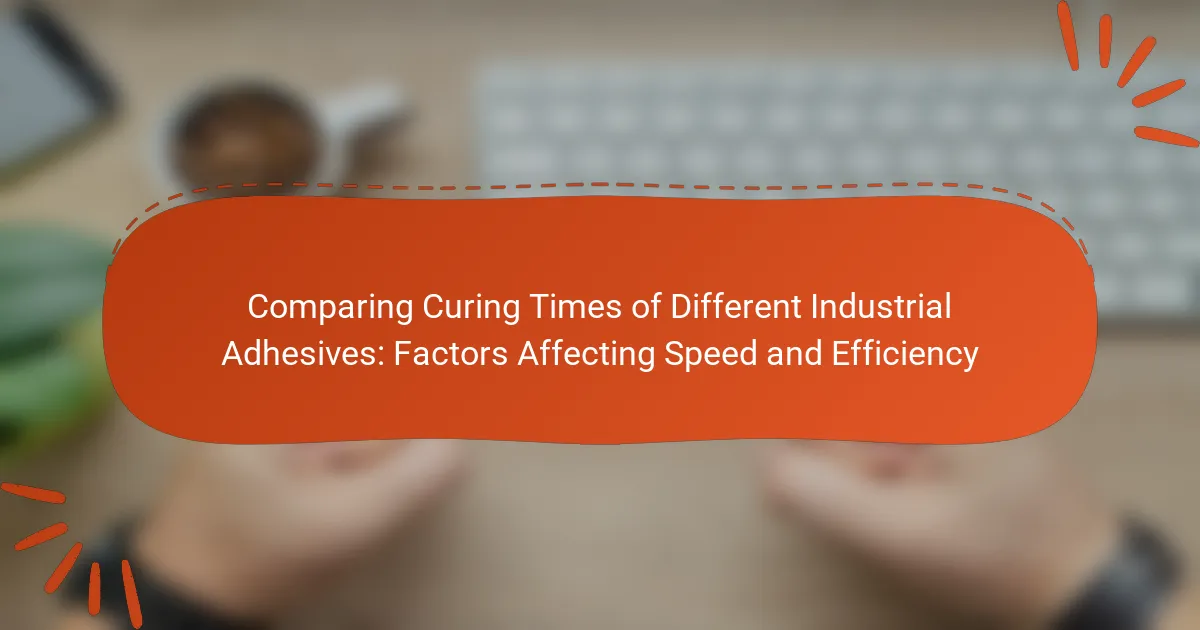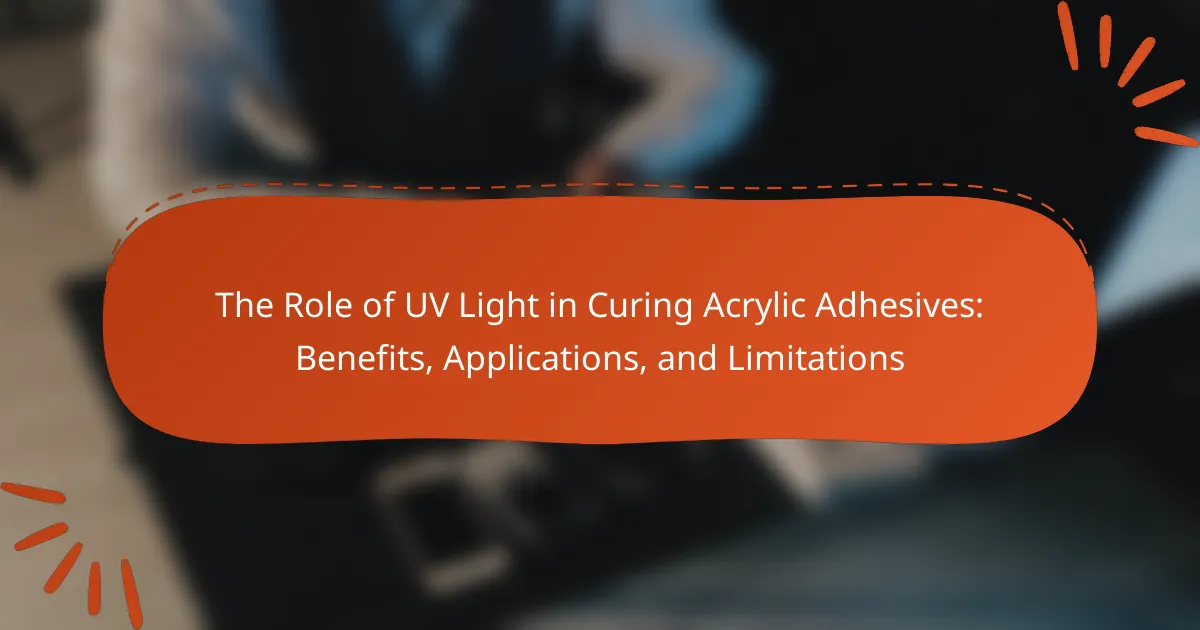Surface preparation is a critical factor in the curing of industrial adhesives, as it directly impacts the effectiveness of adhesive bonding. Proper surface preparation techniques, including cleaning, profiling, and controlling environmental conditions, enhance adhesion by ensuring optimal contact between surfaces. Contaminants such as dust, oil, and moisture can weaken bonds and extend curing times, while surface roughness can significantly improve adhesive strength. Best practices for surface preparation are essential for achieving reliable and long-lasting results in load-bearing applications, making meticulous preparation vital for successful industrial adhesive use.

What is the impact of surface preparation on the curing of industrial adhesives?
Surface preparation significantly influences the curing of industrial adhesives. Proper surface preparation enhances adhesive bonding by ensuring optimal contact between surfaces. Clean and appropriately textured surfaces allow adhesives to penetrate and bond effectively. Contaminants such as dust, oil, or moisture can hinder adhesion and prolong curing times. Additionally, surface roughness can increase the surface area for bonding, improving overall adhesive strength. Studies show that inadequately prepared surfaces can lead to bond failures, emphasizing the importance of meticulous preparation. Thus, effective surface preparation is crucial for achieving desired curing outcomes in industrial adhesive applications.
How does surface preparation influence adhesive performance?
Surface preparation significantly influences adhesive performance. Proper preparation enhances adhesion by removing contaminants, such as dust, oil, or oxidation. This creates a clean surface for the adhesive to bond effectively. Additionally, surface roughness can increase the contact area between the adhesive and the substrate. Increased contact area often leads to improved mechanical interlocking. Research shows that prepared surfaces can boost adhesive strength by up to 50%. Techniques like sanding, blasting, or chemical cleaning are commonly used to achieve optimal surface conditions. These methods ensure that the adhesive can cure properly and achieve its intended performance.
What are the key factors in surface preparation?
Key factors in surface preparation include cleanliness, surface profile, and moisture content. Cleanliness ensures the removal of contaminants like dust, oil, and grease. A clean surface promotes better adhesion of industrial adhesives. Surface profile affects how well the adhesive bonds to the material. An appropriate texture increases the surface area for adhesion. Moisture content is critical, as excess moisture can weaken adhesive bonds. Properly prepared surfaces lead to optimal curing of adhesives. Studies show that well-prepared surfaces enhance adhesive performance significantly.
How does surface cleanliness affect curing times?
Surface cleanliness significantly affects curing times of industrial adhesives. Contaminants like dust, oil, and moisture can hinder adhesion. Clean surfaces promote better contact between adhesive and substrate. This results in faster chemical reactions necessary for curing. Studies show that surfaces with less than 1% contamination cure up to 30% faster. In contrast, dirty surfaces can delay curing by several hours or even days. Proper surface preparation ensures optimal adhesive performance and reduces overall production time.
What types of surface preparation methods are commonly used?
Commonly used surface preparation methods include mechanical, chemical, and thermal techniques. Mechanical methods involve sanding, grinding, or blasting surfaces to create a clean profile. Chemical methods utilize solvents or primers to remove contaminants and enhance adhesion. Thermal techniques apply heat to alter the surface properties of materials. Each method ensures optimal bonding for industrial adhesives. For instance, abrasive blasting can remove rust and old coatings, providing a suitable surface for adhesion.
What are the differences between mechanical and chemical preparation methods?
Mechanical preparation methods involve physical processes to alter a surface, such as grinding, sanding, or blasting. These methods enhance surface roughness and remove contaminants. They provide immediate results and do not involve chemical reactions. Mechanical methods are often faster and can be controlled easily.
Chemical preparation methods, on the other hand, involve the use of chemical agents to clean or modify surfaces. This includes processes like acid etching or solvent cleaning. Chemical methods can effectively remove contaminants at a molecular level. They may require longer processing times and can involve safety precautions due to the chemicals used.
In summary, mechanical methods rely on physical actions, while chemical methods utilize chemical reactions. Each method has its advantages and applications depending on the specific requirements of surface preparation for industrial adhesives.
How do various methods affect the adhesive bond strength?
Various methods significantly affect adhesive bond strength. Surface preparation techniques such as cleaning, sanding, and priming enhance adhesion. Cleaning removes contaminants that hinder bonding. Sanding increases surface roughness, providing more area for adhesive contact. Priming creates a chemical bond between the adhesive and substrate. Studies show that proper surface preparation can improve bond strength by up to 50%. For instance, a study by P. G. K. et al. in the Journal of Adhesion Science and Technology highlights that treated surfaces exhibit higher tensile strength compared to untreated ones. Thus, the method of surface preparation directly influences the effectiveness of adhesive bonds.

Why is surface preparation critical for industrial adhesives?
Surface preparation is critical for industrial adhesives because it ensures proper bonding. Clean, smooth surfaces enhance adhesive performance. Contaminants like dust, oil, and moisture can weaken the bond. Studies show that prepared surfaces increase adhesion strength by up to 50%. Surface roughness also improves mechanical interlocking. This is essential for load-bearing applications. Proper preparation techniques include cleaning, sanding, and priming. These methods promote optimal curing and long-lasting results.
What are the consequences of inadequate surface preparation?
Inadequate surface preparation can lead to poor adhesion of industrial adhesives. This results in reduced bond strength and compromised structural integrity. Contaminants such as dust, oil, or moisture can hinder adhesive performance. If surfaces are not properly cleaned or primed, the adhesive may not cure effectively. This could lead to premature failure of the bonded materials. Studies show that up to 70% of adhesive failures are due to insufficient surface preparation. Ensuring proper preparation is crucial for optimal adhesive performance and longevity.
How does poor preparation lead to adhesive failure?
Poor preparation leads to adhesive failure by creating inadequate bonding surfaces. Contaminants like dust, oil, or moisture hinder adhesion. Uneven surfaces can prevent full contact between adhesive and substrate. Improper cleaning methods may leave residues that weaken the bond. Additionally, insufficient surface roughness can reduce mechanical interlocking. Research indicates that up to 70% of adhesive failures are linked to surface preparation issues. Proper preparation ensures optimal adhesion and enhances durability.
What are the long-term effects of improper surface preparation?
Improper surface preparation can lead to long-term adhesion failures. These failures often result in delamination of bonded surfaces. Additionally, there may be an increase in moisture infiltration. Contaminants can remain trapped, leading to corrosion or degradation. Over time, this affects the structural integrity of the assembly. Research indicates that up to 70% of adhesive failures are due to inadequate surface preparation. This highlights the critical importance of proper techniques for long-lasting adhesion.
How can surface preparation be optimized for specific adhesives?
Surface preparation can be optimized for specific adhesives by ensuring the correct cleaning, roughening, and priming processes are applied. Cleaning removes contaminants that can hinder adhesion. Common methods include solvent wiping, abrasive blasting, or chemical cleaning. Roughening the surface increases the bonding area. Techniques such as sanding or grinding can achieve this. Priming can enhance adhesion for certain adhesives. Primers create a suitable interface for the adhesive. Each adhesive type may have specific requirements for these processes. For instance, epoxy adhesives may require a different surface treatment than polyurethane adhesives. Following manufacturer guidelines ensures optimal performance.
What role does the adhesive type play in preparation methods?
The adhesive type significantly influences preparation methods. Different adhesives require specific surface conditions for optimal bonding. For instance, epoxy adhesives often need a clean, roughened surface to enhance mechanical interlocking. In contrast, pressure-sensitive adhesives may adhere well to smooth surfaces without extensive preparation. The chemical composition of the adhesive also determines the required surface treatment. Solvent-based adhesives might necessitate degreasing to remove contaminants. Additionally, moisture-sensitive adhesives demand dry surfaces to prevent bonding failure. Understanding these requirements is crucial for effective application and long-lasting results.
How can environmental conditions affect surface preparation effectiveness?
Environmental conditions significantly impact surface preparation effectiveness. Factors such as temperature, humidity, and air quality can alter the adhesion properties of surfaces. High humidity can lead to moisture retention, which may hinder proper bonding. Low temperatures can slow down the curing process of adhesives. Dust and contaminants in the air can compromise surface cleanliness, affecting adhesion quality. Studies show that optimal surface preparation occurs within specific environmental parameters. For instance, ideal temperature ranges for adhesive curing are typically between 20°C to 30°C. Therefore, controlling environmental conditions is crucial for ensuring effective surface preparation and optimal adhesive performance.

What best practices should be followed for effective surface preparation?
Effective surface preparation involves cleaning, profiling, and ensuring proper environmental conditions. Cleaning removes contaminants like dust, grease, and oils. Use solvents or detergents suitable for the surface material. Profiling enhances adhesion by creating a textured surface. Techniques include sanding, blasting, or etching. Environmental conditions should be controlled; temperature and humidity affect adhesive performance. Ideal conditions are typically between 50°F and 90°F with low humidity. Following these best practices improves adhesion and overall performance of industrial adhesives.
How can industries implement effective surface preparation techniques?
Industries can implement effective surface preparation techniques by following established best practices. These practices include cleaning, sanding, and priming surfaces to ensure proper adhesion. Cleaning involves removing contaminants such as dust, grease, and oils. For example, using solvents or detergents can enhance surface cleanliness. Sanding creates a rough texture that improves mechanical bonding. It is essential to use the correct grit size for the material being prepared. Priming applies a suitable adhesive primer to enhance adhesion and protect the substrate. Research indicates that properly prepared surfaces can increase adhesive bond strength significantly. A study by the Adhesive and Sealant Council found that effective surface preparation can improve bond durability by up to 50%.
What are the recommended steps for preparing surfaces?
The recommended steps for preparing surfaces include cleaning, sanding, and priming. Cleaning removes contaminants such as dust, grease, and oil. Use a suitable solvent or cleaner for effective removal. Sanding creates a rough texture for better adhesion. Choose the appropriate grit size based on the surface material. Priming enhances adhesion and provides a uniform surface. Apply a compatible primer before the adhesive. Following these steps ensures optimal curing of industrial adhesives. Proper surface preparation can significantly improve bond strength and durability.
How can training improve surface preparation outcomes?
Training can significantly enhance surface preparation outcomes. It equips workers with essential skills and knowledge. Proper training ensures adherence to best practices in surface cleaning and treatment. Techniques learned can reduce contaminants that interfere with adhesive bonding. Research indicates that trained personnel achieve better surface finishes. For instance, a study by the American Institute of Steel Construction found that trained workers improved adhesion strength by 30%. This improvement directly correlates with effective surface preparation methods. Thus, training leads to higher quality and more reliable adhesive performance.
What common mistakes should be avoided in surface preparation?
Common mistakes to avoid in surface preparation include inadequate cleaning, improper surface profiling, and neglecting moisture control. Inadequate cleaning can leave contaminants that interfere with adhesive bonding. Proper surface profiling ensures optimal adhesion; failing to achieve this can result in weak bonds. Neglecting moisture control can lead to adhesive failure, as excess moisture affects curing. Additionally, using the wrong type of primer or not allowing sufficient drying time can compromise the bond strength. Each mistake can significantly impact the effectiveness of industrial adhesives.
How can improper cleaning methods compromise adhesive performance?
Improper cleaning methods can significantly compromise adhesive performance. Contaminants such as dust, oil, and moisture can remain on the surface. These contaminants prevent proper bonding between the adhesive and the substrate. Insufficient cleaning can lead to weak adhesive joints that may fail under stress. Studies show that a clean surface enhances adhesion strength by up to 50%. Additionally, residues from cleaning agents can interfere with the curing process. This can result in incomplete polymerization of the adhesive. Ultimately, inadequate surface preparation leads to reduced durability and longevity of the bond.
What are the signs of inadequate surface preparation during application?
Signs of inadequate surface preparation during application include poor adhesion, visible contaminants, and uneven surfaces. Poor adhesion manifests as peeling or lifting of the adhesive. Contaminants like dust, grease, or moisture can lead to failure in bonding. Uneven surfaces can create gaps, resulting in weak spots. Additionally, bubbling or blistering may occur due to trapped air or moisture. Discoloration of the adhesive may indicate improper surface treatment. These signs can compromise the effectiveness of industrial adhesives. Proper surface preparation is essential for optimal curing and performance.
What tips can enhance the curing process of industrial adhesives?
To enhance the curing process of industrial adhesives, ensure optimal surface preparation. Clean surfaces remove contaminants that can hinder adhesion. Use appropriate solvents or cleaners to achieve a residue-free surface. Additionally, control the temperature and humidity during curing to meet the adhesive’s specifications. Most adhesives cure faster at higher temperatures, while humidity can affect the curing rate. Follow the manufacturer’s guidelines for curing times and conditions. Properly mixing adhesive components is also crucial for achieving the desired performance. Lastly, apply the adhesive uniformly to prevent weak spots and ensure even curing.
The main entity of this article is surface preparation in the context of industrial adhesives. The article explores how surface preparation impacts the curing process and adhesive performance, emphasizing the importance of cleanliness, surface profile, and moisture control. It details various surface preparation methods, including mechanical and chemical techniques, and their effects on bond strength. Additionally, the article highlights common mistakes to avoid and best practices for optimizing surface preparation to enhance adhesive curing outcomes. Overall, proper surface preparation is critical for achieving reliable and durable adhesive bonds in industrial applications.



